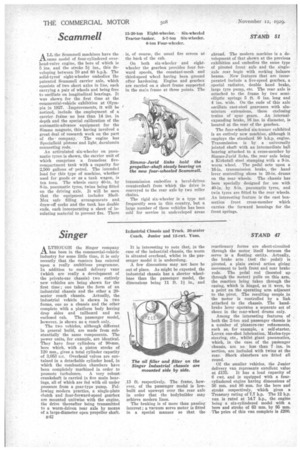Scarninell
Page 180

If you've noticed an error in this article please click here to report it so we can fix it.
A LL the Scammell machines have the same model of four-cylindered overhead-valve engine, the bore of which is 5 ins, and the stroke 5f ins., this developing between 70 and 80 b.p.h. The solid-tyred eight-wheeler embodies the patented Scamtnell carrier axle, which consists of two short axles in line, each carrying a pair of wheels and being free to oscillate on longitudinal bearings. It was shown for the first time at the commercial-vehicle exhibition at Olympia in 1927. Improvements, it will be noticed, include the employment of a carrier frime no less than 14 ins, in depth and the special calibration of the automatic-advance equipment for the Simms magneto, this having involved a great deal of research work on the part of the, company. The engine has Speeialloid pistons and light duralumin connecting rods. •
An articulated six-wheeler on pneumatic tyres is shown, the carrier unit of which comprises a frameless fivecompartment tank with a capacity for 2,500 gallons of petrol. The intended load for this type of machine, whether used for goods or as a tank wagon, is ten tons. The wheels carry 40-in. by 8-in, pneumatic tyres, twins being fitted on the driving axle. It will be seen that the equipment includes ShellMex safe filling arrangements and. draw-off cocks and the tank has double ends, each incorporating a sheet of insulating material to prevent fire. There is, of course, the usual fire screen at the back of the cab.
On both six-wheeler and eightwheeler the gearbox provides four forward speeds, the constant-mesh and third-speed wheel having been ground after hardening. Engine and gearbox are carried on a short frame supported in the main frame at three points. The transmission embodies a bevel-driven countershaft from which the drive is conveyed to the rear axle by two roller chains.
The rigid six-wheeler is a type not frequently seen in this country, but a large number of these vehicles has been sold for service in undeveloped areas abroad. The modern machine is a development of that shown at the previous exhibition and embodies the same type of pivoted front axle and the singleaxle rear bogie with rocking balance beams. New features that are incorporated include a five-speed gearbox, a special radiator, double hand brake, large tyre pump, etc. The rear axle is attached to the frame by two semielliptic springs 5 ft. 6 ins, long and 4 ins. wide. On the ends of this axle oscillate cast-steel gearcases with aluminium extensions, these enclosing
trains of spur gears. An internal. expanding brake, 16 ins, in diameter, is located at the rear of the gearbox.
The four-wheeled six-tanner exhibited Is an entirely new machine, although it employs the standard 80 b.h.p. engine. Transmission is by a universally jointed shaft with an intermediate ball bearing attached to a cross-member by Simtns-Ju rid links, the rear axle being Kirkstall steel stamping with a 9-in. worm wheel. The pedal acts upon a 16-in, transmission brake, the hand lever controlling shoes in 20-in, drums on the rear wheels. The chassis has been specially designed for use with 40-in. by 8-in, pneumatic tyres, and twin tyres are fitted to the rear wheels. An interesting feature is the cast boxsection front cross-member which carries the forward housings for the front springs.








































































































































































































































































































































